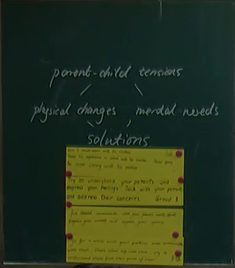- 时间点:
- 时 分 秒 当前视频时间点
- 问题:
-
- 选项一
设为正确答案
新增选项 - 选项一
- 正确跳转时间:
- 时 分 秒 同锚点时间
- 错误跳转时间:
- 时 分 秒 同锚点时间


恭喜你,回答正确~
很遗憾,回答错误~
正确答案: ,您可以



【What】本板块话题为“亲子矛盾冲突”,语篇是一篇关于处于青春期的青少年与父母之间矛盾冲突的杂志文章,阐述了亲子关系紧张的主要起因和解决办法,旨在帮助学生理性认识身心发展的不平衡及由此带来的亲子矛盾冲突现象,学会如何平稳度过敏感的青春期。
【Why】本文通过分析青少年青春期时与父母之间的紧张关系,引导学生以积极、理性的态度面对青春期个人身心变化,选择正确的方式与父母相处,为青少年身心健康的协调发展奠定良好的基础。
【How】本文的语篇类型为议论文,文章结构清晰、逻辑缜密。首段提出“青春期亲子冲突是普遍现象”的观点;第二、三两段分别论述造成青少年与父母关系紧张的生理及心理原因;第四段提出定期真诚的沟通是良好亲子关系的关键;第五段呼应前文,重申首段的观点和第四段的建议。此外,标题“ Strangers under the same roof?”使用疑问句并制造反差,吸引读者的注意力;文章以问句开篇,进一步激发阅读兴趣,引发读者的深入思考。
本文话题贴近学生生活,文章5段,整体结构清晰,从问题~原因~解决办法~总结,层层深入。适合学生进行预测和逐段阅读。
高一学生来自不同的各乡镇学校,英语基础及水平参差不齐。班上部分学生英语学习兴趣较浓厚,有一定的英语学习基础,并具备相应的自主学习能力。但也存在部分学生英语基础相对比较薄弱,有一定的畏惧心理。学生整体词汇量较少,在初中阶段的英语基础语法都掌握不是很牢固。
但学生已掌握一定的阅读技巧,在进行一些快速阅读和细节阅读时,学生基本能胜任,但一些不能从文章中得出结论,需要自己结合文章内化知识表达个人观点时,学生还有些吃力,需要老师启发或进行小组讨论才能更好输出。因此,在高一的英语教学阶段,本人将坚持低起点、爬坡走、抓习惯,善引导的原则,长期不懈地抓好学生的英语学习兴趣,习惯养成以及思维品质的培养和提升。
By the end of this section, students will be able to:
1. grasp the theme, outline and details of the article;
2.explain the causes of the tensions between parents and children and give practical advice;
3. adopt a positive attitude and practical solutions to deal with real-life parent-child tensions;
Teaching key important and difficult points:
1. To grasp the outline and details of the article.
2. To analyze the reasons of the family tension and find out the solutions.
Blackboard design:
Strangers under the same roof?
Parent-child tensions
physical changes mental needs Father And Mother
Solutions I Love You
Conclusion
Family


Teaching procedures:
Step1: Pre-reading
1. Ask students to predict some information according to the title and pictures.
(1) Who does “strangers” refer to?
(2) What might be discussed in this article?
(设计意图:让学生通过图片和标题进行相关预测。)
Step 2: While-reading
2. Let students read paragraphs one by one and answer the following questions.
para. 1
(1) What problems are common between teenagers and their parents?
Introduction of the problem.(学生小结)
What might be discussed next?
Causes of the problem.(学生预测)
para. 2
(2) What physical changes might teenagers worry about?
Further thinking:
Who will be the first targets of your anger?Why?(学生讨论)
para. 3
(3) What does “a middle ground”in line 15 mean?
(4) What are two kinds of mental needs that teenagers have?
Further thinking:
Your parents treat you like a child but expect you to act like an adult. Do you feel the same way or not? Give an example.(学生讨论)
Solutions to the problem(学生预测)
para. 4
(5)How can teenagers solve problems with their parents?
para. 5
(6)What’s the author’s attitude to parent-child tensions?
A. indifferent( 漠不关心的) B. optimistic (乐观的)
C. pessimistic (悲观的) D. neutral (中立的)
(设计意图:把握语篇信息,培养学生查找、概括信息并能恰当表达的能力。引导学生以积极、理性的态度面对青春期个人身心变化,选择正确的方式与父母相处,为青少年身心健康的协调发展奠定良好的基础。)
3.Let students summarize the structure of the whole article.
(设计意图:梳理文本,总结文章结构大意。)
Step 3: Post-reading
Work in pairs, giving Bob advice on how to deal with parent-child tensions. (学生活动)
(设计意图:结合课文信息,利用所学内容,进行语言输出,提高学生的语用能力。同时培养他们能够用英语解决问题的能力,当别人需要帮助时,能主动积极地提供帮助。)
Share an ad with students. (Family内涵解读,情感升华)
结束语:

Further thinking:
tension---love
Strangers under the same roof?--------__Friends___under the same roof!
(最终回到标题解读,Change tensions into love, there are no strangers under the same roof,but friends under the same roof.)
Homework
1. Draw a mind-map of the whole article.
2.Write Bob a letter of advice on how to deal with parent-child tensions.
_____________________________________________________________________________
_____________________________________________________________________________
_____________________________________________________________________________
设为正确答案